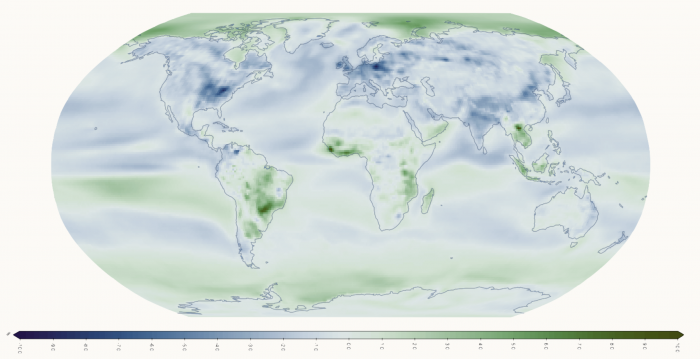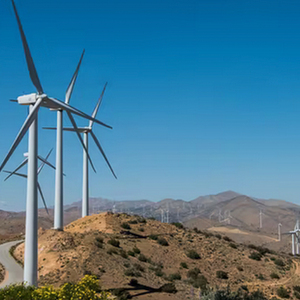
This article originally appeared at Yale Environment 360.
Last year, from summer into fall, much of Europe experienced what’s known as a “wind drought.” Wind speeds in many places slowed about 15% below the annual average, and in other places, the drop was even more pronounced. It was one of the least windy periods in the United Kingdom in the past 60 years, and the effects on power generation were dramatic. Wind farms produced 18% of the U.K.’s power in September of 2020, but in September of 2021, that percentage plummeted to only 2%. To make up the energy gap, the U.K. was forced to restart two mothballed coal plants.
The recent declines in surface winds over Europe renewed concerns about a “global terrestrial stilling” linked with climate change. From 1978 until 2010, research showed a worldwide stilling of winds, with speeds dropping 2.3% per decade. In 2019, though, a group of researchers found that after 2010, global average wind speeds had actually increased—from 7 mph to 7.4 mph.
Despite those conflicting data, the Intergovernmental Panel on Climate Change forecasts slowing winds for the coming decades. By 2100, that body says, average annual wind speeds could drop by up to 10%.
“Why do we have wind at all on the planet?” asks Paul Williams, who studies wind as a professor of atmospheric science at the University of Reading in England. “It’s because of uneven temperatures—very cold at the poles and warm at the tropics. That temperature difference drives the winds, and that temperature difference is weakening. The Arctic is warming faster than the tropics.”
A slowing in surface winds could disrupt the Gulf Stream, contributing to drought and more intense winter storms.
According to a recent study in Nature, the Arctic has, since 1979, been warming four times faster than the rest of the world. That’s much quicker than scientists had previously thought, and this warming could presage an even steeper decline in wind than anticipated. Another factor possibly contributing to stilling is an increase in “surface roughness”—an uptick in the number and size of urban buildings, which act as a drag on winds.
Wind has been an overlooked element of climate change studies, which helps explain why the debate over these trends continues. The field is young, with only 70 years of data—temperature data, by contrast, goes back thousands of years—and wind systems are notoriously difficult to study and analyze. Substantial annual fluctuations make long-term trends difficult to detect, and conclusions are rarely firm.
“By using the Pliocene as an analog for modern global warming, it seems likely that the movement of the westerlies”—the prevailing mid-latitude winds that blow from west to east—“towards the poles observed in the modern era will continue with further human-induced warming,” says Gisela Winckler, a researcher at Columbia University’s Lamont Doherty Earth Observatory and an author of the Pliocene dust paper. Her models indicate “that the winds [will be] weaker, and stiller.”

Projected change in average wind speeds under 1.5 degrees C of warming. Blue indicates slower winds, green faster winds. IPCC
Another recent study found that there will be regional and seasonal variability in winds in the United States as carbon dioxide levels increase: by 2100, wind speeds will decrease over most of the western U.S. and the East Coast, but the central U.S. will see an increase. Several other studies predict similar variability—both regional and seasonal—worldwide.
The uncertainty, says Williams, is “a fundamental signal-to-noise problem that’s inherent in nature. From one year to the next there’s a lot of variability, and it’s difficult to extract a long-term signal when there is a lot of variability taking place at the same time.”
Plants will feel the effects
A stilling or an increase in winds could have serious repercussions for both the human and non-human world. “Wind affects plant growth, reproduction, distribution, death and ultimately plant evolution,” wrote the plant physiologist P.S. Nobel in a 1981 paper titled “Wind as an Ecological Factor.”
Giant sequoias on the U.S. West Coast, for example, depend on regular deliveries of phosphorous blowing in from the Gobi Desert, across the Pacific Ocean. And surface winds are responsible for driving the Gulf Stream, the ocean current that drives much of the world’s climate. A slowing in surface winds could disrupt this conveyor, contributing to drought, colder weather, and more intense winter storms. Higher than normal winds can damage or destroy trees and will increase rates of evapotranspiration—a challenge for farmers and ranchers in already dry areas. And more extreme winds have been linked with worsening wildfire seasons in the western U.S.
“The recent wind drought is a clear reminder of how variable [wind energy] generation can be,” writes one researcher.
Brisk winds can help relieve cities choking on pollution and replace stagnant air with fresh. Slower winds, on the other hand, exacerbate the misery of heat waves, which are predicted to become more frequent and longer lasting. Slow winds also make it more difficult for planes to take off because pilots rely on headwinds for lift. In the last 30 years, the maximum takeoff weight for an Airbus 320 has decreased by 4 tons at one airport in Greece, according to Williams, due to both slowing headwinds and rising temperatures.
Impact on clean energy production
Global stilling, if it happens, will have a massive impact on alternative energy production. “A 10% drop in winds does not mean a 10% drop in energy,” Williams says. Turbines are somewhat inefficient, with limits on how much energy they can extract from the wind. According to Williams, a 10% decline in wind speeds would actually result in “a 30% drop, and that would be catastrophic.”
Europe is all in on wind power as an alternative to coal and other fossil fuels. The United Kingdom generates about 24% of its energy from more than 11,000 on- and offshore wind turbines, and the European Union gets about 15% of its electricity from wind. That percentage is growing as more wind turbines come online. In the U.S., wind farms provide nearly 10% of utility-scale electricity generation. By 2050 the amount of power produced is projected to nearly quadruple. But if wind speeds diminish, it could be harder to reach that goal.
Hannah Bloomfield, a postdoctoral researcher at the University of Bristol, studies wind and wind energy. She believes that, until recently, changes in wind speed have been within the range of variability, and that there is no solid evidence, today, of global stilling induced by climate change. But models of the future are of more concern. “Studies show if you start to take it forward, past 2050, the IPCC’s arguments [for stilling] start to look a lot more convincing.”
“The recent wind drought is a clear reminder of how variable this form of generation can be,” she wrote last year in The Conversation, “and it cannot be the sole investment for a reliable future energy grid.”
Dealing with wind-energy droughts will require new strategies for energy storage and reliable alternatives, says Upmanu Lall, a professor of civil engineering at Columbia University. Because of the variability of both wind and sunshine, alternative energy is “starting to look more like a water system than an energy system,” he says. Just as water systems with their variable supplies need to be managed to accommodate precipitation trends that occur over yearly, decadal, and century-long scales, “this is going to be part of the lexicon of the energy system as well.”
Most current battery technology will not help during extended energy droughts, Lall says, since today’s batteries store energy only for several days. “Many people are discussing hydrogen and nuclear in this context,” he continues. “You can create hydrogen when you have excess solar and wind, and it can be used when you have a [renewable energy] shortage.” Excess renewable energy can also be used to pump water uphill to a reservoir; energy is generated later by releasing water back downhill, passing through a turbine.
The impact on energy markets
Decreasing winds could also exacerbate the volatility of energy markets. If natural gas prices spike—because of war in Ukraine, say, or an especially cold winter—at the same time as a regional stilling event, energy prices could rise beyond the means of millions. Natural gas prices in Europe rose more than 450% during last year’s European stilling, and electricity prices in the Nordic region rose by up to 470% over the previous year.
While stilling has occurred in some parts of the world, anecdotal reports in other places suggest that the wind is blowing more fiercely—and more often—than ever before. Earlier this year in central New Mexico, for example, wildland firefighters, ranchers, and others described wind events as unprecedented. Martin Baca, a long-time alfalfa grower and rancher south of Albuquerque, said he’s never seen the wind blow as often as it recently has. “You can irrigate, and five days later it’s dry,” he said. “That hot wind is like a hair dryer. And there’s no dew [to] help the grass grow.”
Unfortunately, science has yet to get a handle on where wind stilling and wind increases—triggered by long-term climate-change trends—will occur. “There’s no settled science here,” Williams says. The 2019 paper, which indicated speedier winds over a nine-year period, was confounded by last summer’s European doldrums.
“Things have tipped the other way again,” Williams says, sounding resigned to the uncertainties. “It’s not supposed to be that calm over Europe in the summer.”
Jim Robbins is a journalist based in Helena, Montana, and a frequent contributor to Yale Environment 360.
Weekly Newsletter
Get building science and energy efficiency advice, plus special offers, in your inbox.














2 Comments
"Another factor possibly contributing to stilling is an increase in “surface roughness”—an uptick in the number and size of urban buildings, which act as a drag on winds."
Wind turbines will contribute significantly to surface roughness and slow the wind in environments which typically have very little surface roughness, like offshore wind farms. The more wind turbines we build the more global winds may decrease, and the local impact of large wind farms could be significant for all the reasons mentioned.
Volatility of wind and solar should be a good reason not to depend heavily on them for energy. Supplemental energy sources, sure, but not primary.
Agree with you
Log in or create an account to post a comment.
Sign up Log in